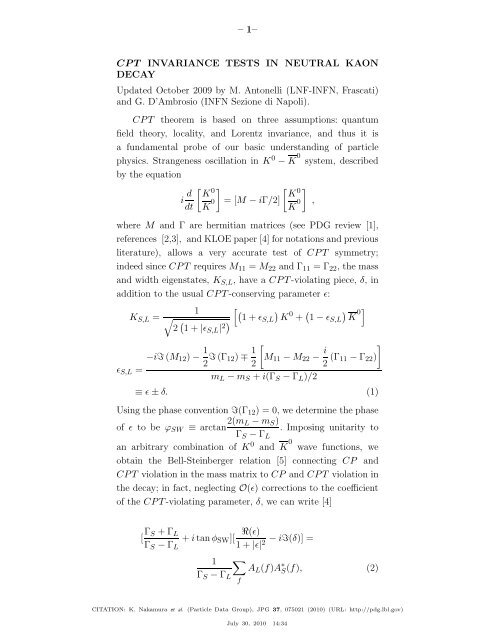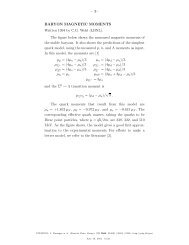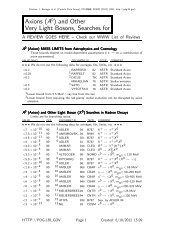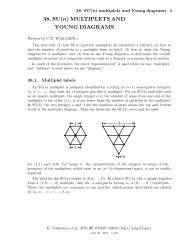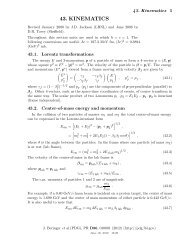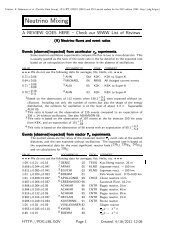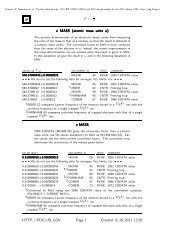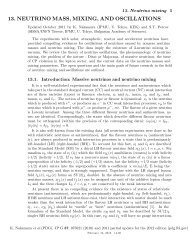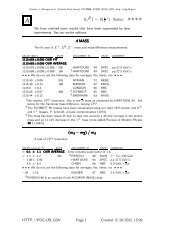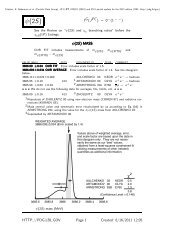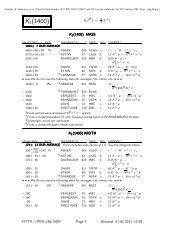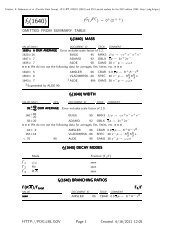CPT Invariance Tests in Neutral Kaon Decay - Particle Data Group
CPT Invariance Tests in Neutral Kaon Decay - Particle Data Group
CPT Invariance Tests in Neutral Kaon Decay - Particle Data Group
You also want an ePaper? Increase the reach of your titles
YUMPU automatically turns print PDFs into web optimized ePapers that Google loves.
–1–<br />
<strong>CPT</strong> INVARIANCE TESTS IN NEUTRAL KAON<br />
DECAY<br />
Updated October 2009 by M. Antonelli (LNF-INFN, Frascati)<br />
and G. D’Ambrosio (INFN Sezione di Napoli).<br />
<strong>CPT</strong> theorem is based on three assumptions: quantum<br />
field theory, locality, and Lorentz <strong>in</strong>variance, and thus it is<br />
a fundamental probe of our basic understand<strong>in</strong>g of particle<br />
physics. Strangeness oscillation <strong>in</strong> K0 − K 0 system, described<br />
by the equation<br />
i d<br />
dt<br />
<br />
K0 K 0<br />
<br />
<br />
K0 =[M − iΓ/2]<br />
K 0<br />
<br />
,<br />
where M and Γ are hermitian matrices (see PDG review [1],<br />
references [2,3], and KLOE paper [4] for notations and previous<br />
literature), allows a very accurate test of <strong>CPT</strong> symmetry;<br />
<strong>in</strong>deed s<strong>in</strong>ce <strong>CPT</strong> requires M11 = M22 and Γ11 =Γ22, themass<br />
and width eigenstates, KS,L, havea<strong>CPT</strong>-violat<strong>in</strong>g piece, δ, <strong>in</strong><br />
addition to the usual <strong>CPT</strong>-conserv<strong>in</strong>g parameter ɛ:<br />
KS,L =<br />
1<br />
<br />
2 1+|ɛS,L| 2<br />
1+ɛS,L 0 0<br />
K + 1 − ɛS,L K <br />
−iℑ (M12) −<br />
ɛS,L =<br />
1<br />
2 ℑ (Γ12) ∓ 1<br />
<br />
M11 − M22 −<br />
2<br />
i<br />
2 (Γ11<br />
<br />
− Γ22)<br />
mL − mS + i(ΓS − ΓL)/2<br />
≡ ɛ ± δ. (1)<br />
Us<strong>in</strong>g the phase convention ℑ(Γ12) = 0, we determ<strong>in</strong>e the phase<br />
of ɛ to be ϕSW ≡ arctan 2(mL − mS)<br />
. Impos<strong>in</strong>g unitarity to<br />
ΓS − ΓL<br />
an arbitrary comb<strong>in</strong>ation of K 0 and K 0 wave functions, we<br />
obta<strong>in</strong> the Bell-Ste<strong>in</strong>berger relation [5] connect<strong>in</strong>g CP and<br />
<strong>CPT</strong> violation <strong>in</strong> the mass matrix to CP and <strong>CPT</strong> violation <strong>in</strong><br />
the decay; <strong>in</strong> fact, neglect<strong>in</strong>g O(ɛ) corrections to the coefficient<br />
of the <strong>CPT</strong>-violat<strong>in</strong>g parameter, δ, we can write [4]<br />
[ ΓS +ΓL<br />
ΓS − ΓL<br />
+ i tan φSW][ ℜ(ɛ)<br />
− iℑ(δ)] =<br />
1+|ɛ| 2<br />
1<br />
ΓS − ΓL<br />
<br />
f<br />
AL(f)A ∗ S (f), (2)<br />
CITATION: K. Nakamura et al. (<strong>Particle</strong> <strong>Data</strong> <strong>Group</strong>), JPG 37, 075021 (2010) (URL: http://pdg.lbl.gov)<br />
July 30, 2010 14:34
–2–<br />
where AL,S(f) ≡ A(KL,S → f). We stress that this relation<br />
is phase-convention-<strong>in</strong>dependent. The advantage of the neutral<br />
kaon system is that only a few decay modes give significant<br />
contributions to the r.h.s. <strong>in</strong> Eq. (2); <strong>in</strong> fact, def<strong>in</strong><strong>in</strong>g for the<br />
hadronic modes<br />
αi ≡ 1<br />
〈AL(i)A<br />
ΓS<br />
∗ S (i)〉 = ηi B(KS → i),<br />
i = π 0 π 0 ,π + π − (γ), 3π 0 ,π 0 π + π − (γ), (3)<br />
the recent data from CPLEAR, KLOE, KTeV, and NA48 have<br />
led to the follow<strong>in</strong>g determ<strong>in</strong>ations (the analysis described <strong>in</strong><br />
Ref. 4 has been updated by us<strong>in</strong>g the recent measurements of<br />
KL branch<strong>in</strong>g ratios from KTeV [6] and NA48 [7,8])<br />
α π + π − = ((1.112 ± 0.013) + i(1.061 ± 0.014)) × 10 −3 ,<br />
α π 0 π 0 = ((0.493 ± 0.007) + i(0.471 ± 0.007)) × 10 −3 ,<br />
α π + π − π 0 = ((0 ± 2) + i(0 ± 2)) × 10 −6 ,<br />
|α π 0 π 0 π 0| < 7 × 10 −6<br />
at 95% CL . (4)<br />
The semileptonic contribution to the right-handed side of<br />
Eq. (2) requires the determ<strong>in</strong>ation of several observables: we<br />
def<strong>in</strong>e [2,3]<br />
A(K 0 → π − l + ν)=A0(1 − y) ,<br />
A(K 0 → π + l − ν)=A ∗ 0 (1 + y∗ )(x+ − x−) ∗ ,<br />
A(K 0 → π + l − ν)=A ∗ 0 (1 + y∗ ) ,<br />
A(K 0 → π − l + ν)=A0(1 − y)(x+ + x−) , (5)<br />
where x+ (x−) describes the violation of the ΔS = ΔQ<br />
rule <strong>in</strong> <strong>CPT</strong>-conserv<strong>in</strong>g (violat<strong>in</strong>g) decay amplitudes, and y<br />
parametrizes <strong>CPT</strong> violation for ΔS =ΔQ transitions. Tak<strong>in</strong>g<br />
advantage of their tagged K 0 (K 0 ) beams, CPLEAR has<br />
measured ℑ(x+), ℜ(x−), ℑ(δ), and ℜ(δ) [10]. These determ<strong>in</strong>ations<br />
have been improved <strong>in</strong> Ref. 4 by <strong>in</strong>clud<strong>in</strong>g the<br />
<strong>in</strong>formation AS − AL =4[ℜ(δ) +ℜ(x−)], where AL,S are the<br />
KL and KS semileptonic charge asymmetries, respectively, from<br />
the PDG [11] and KLOE [12]. Here we are also <strong>in</strong>clud<strong>in</strong>g the<br />
T -violat<strong>in</strong>g asymmetry measurement from CPLEAR [13].<br />
July 30, 2010 14:34
–3–<br />
Table 1: Values, errors, and correlation coefficients<br />
for ℜ(δ), ℑ(δ), ℜ(x−), ℑ(x+), and<br />
AS + AL obta<strong>in</strong>ed from a comb<strong>in</strong>ed fit, <strong>in</strong>clud<strong>in</strong>g<br />
KLOE [4] and CPLEAR [13].<br />
value Correlations coefficients<br />
ℜ(δ) (3.0 ± 2.3) × 10 −4 1<br />
ℑ(δ) (−0.66 ± 0.65) × 10 −2 − 0.21 1<br />
ℜ(x−) (−0.30 ± 0.21) × 10 −2 − 0.21 −0.60 1<br />
ℑ(x+) (0.02 ± 0.22) × 10 −2 − 0.38 −0.14 0.47 1<br />
AS + AL (−0.40 ± 0.83) × 10 −2 − 0.10 −0.63 0.99 0.43 1<br />
The value AS + AL <strong>in</strong> Table 1 can be directely <strong>in</strong>cluded <strong>in</strong><br />
the semileptonic contributions to the Bell Ste<strong>in</strong>berger relations<br />
<strong>in</strong> Eq. (2)<br />
<br />
〈AL(πℓν)A<br />
πℓν<br />
∗ S (πℓν)〉<br />
Def<strong>in</strong><strong>in</strong>g<br />
απℓν ≡ 1<br />
we f<strong>in</strong>d:<br />
=2Γ(KL → πℓν)(ℜ(ɛ) −ℜ(y) − i(ℑ(x+)+ℑ(δ)))<br />
=2Γ(KL → πℓν)((AS + AL)/4 − i(ℑ(x+)+ℑ(δ))) . (6)<br />
ΓS<br />
<br />
πℓν<br />
〈AL(πℓν)A ∗ S<br />
(πℓν)〉 +2iτKS B(KL → πℓν)ℑ(δ) ,<br />
τKL<br />
(7)<br />
απℓν =((−0.2 ± 0.5) + i(0.1 ± 0.5)) × 10 −5 .<br />
Insert<strong>in</strong>g the values of the α parameters <strong>in</strong>to Eq. (2), we f<strong>in</strong>d<br />
ℜ(ɛ) = (161.2 ± 0.6) × 10 −5 ,<br />
ℑ(δ) =(−0.6 ± 1.9) × 10 −5 . (8)<br />
The complete <strong>in</strong>formation on Eq. (8) is given <strong>in</strong> Table 2.<br />
July 30, 2010 14:34
–4–<br />
Table 2: Summary of results: values, errors,<br />
and correlation coefficients for ℜ(ɛ), ℑ(δ), ℜ(δ),<br />
and ℜ(x−).<br />
value Correlations coefficients<br />
ℜ(ɛ) (161.2 ± 0.6) × 10 −5 +1<br />
ℑ(δ) (−0.6 ± 1.9) × 10 −5 +0.26 1<br />
ℜ(δ) (2.5 ± 2.3) × 10 −4 +0.08 −0.09 1<br />
ℜ(x−) (−4.2 ± 1.7) × 10 −3 +0.13 0.17 −0.43 1<br />
Now the agreement with <strong>CPT</strong> conservation, ℑ(δ) =ℜ(δ) =<br />
ℜ(x−) = 0, is at 30% C.L.<br />
The allowed region <strong>in</strong> the ℜ(ɛ) −ℑ(δ) plane at 68% CL and<br />
95% C.L. is shown <strong>in</strong> the top panel of Fig. 1.<br />
The process giv<strong>in</strong>g the largest contribution to the size of<br />
the allowed region is KL → π + π − , through the uncerta<strong>in</strong>ty on<br />
φ+−.<br />
The limits on ℑ(δ) andℜ(δ) can be used to constra<strong>in</strong> the<br />
K 0 − K 0 mass and width difference<br />
δ = i(mK0 − m K 0)+ 1 2 (ΓK0 − Γ K 0)<br />
cos φSWe<br />
ΓS − ΓL<br />
iφSW [1 + O(ɛ)] .<br />
The allowed region <strong>in</strong> the ΔM =(mK0− m 0), ΔΓ =<br />
K<br />
(ΓK0 − Γ 0) plane is shown <strong>in</strong> the bottom panel of Fig. 1. As<br />
K<br />
a result, we improve on the previous limits (see for <strong>in</strong>stance, P.<br />
Bloch<strong>in</strong>Ref.11)and<strong>in</strong>thelimitΓK0−Γ0 =0weobta<strong>in</strong><br />
K<br />
−5.1×10 −19 GeV
Im(δ) [10 -4 ]<br />
ΔΓ [10 -18 GeV]<br />
0.5<br />
0<br />
-0.5<br />
10<br />
0<br />
-10<br />
–5–<br />
95% CL<br />
68% CL<br />
0.155 0.16 0.165<br />
Re(ε) [10 -2 ]<br />
95% CL<br />
68% CL<br />
-10 0 10<br />
ΔM [10 -18 GeV]<br />
Figure 1: Top: allowed region at 68% and 95%<br />
C.L. <strong>in</strong> the ℜ(ɛ), ℑ(δ) plane. Bottom: allowed<br />
region at 68% and 95% C.L. <strong>in</strong> the ΔM,ΔΓ<br />
plane. Latest KTeV prelim<strong>in</strong>ary results not <strong>in</strong>cluded<br />
<strong>in</strong> these figures.<br />
July 30, 2010 14:34
–6–<br />
References<br />
1. See the “CP Violation <strong>in</strong> Meson <strong>Decay</strong>s,” <strong>in</strong> this Review.<br />
2. L. Maiani, “CP And <strong>CPT</strong> Violation In <strong>Neutral</strong> <strong>Kaon</strong><br />
<strong>Decay</strong>s,” L. Maiani, G. Pancheri, and N. Paver, The<br />
Second Daphne Physics Handbook, Vol.1,2.<br />
3. G. D’Ambrosio, G. Isidori, and A. Pugliese, “CP and<br />
<strong>CPT</strong> mesurements at DAΦNE,” L. Maiani, G. Pancheri,<br />
and N. Paver, The Second Daphne Physics Handbook,<br />
Vol. 1, 2.<br />
4. F. Ambros<strong>in</strong>o et al., [KLOE Collaboration], JHEP 0612,<br />
011 (2006) [arXiv:hep-ex/0610034].<br />
5. J. S. Bell and J. Ste<strong>in</strong>berger, In Wolfenste<strong>in</strong>, L. (ed.):<br />
CP violation, 42-57. (In Oxford International Symposium<br />
Conference on Elementary <strong>Particle</strong>s, September 1965, 195-<br />
208, 221-222). (See Book Index).<br />
6. T. Alexopoulos et al., [KTeV Collaboration], Phys. Rev.<br />
D70, 092006 (1998).<br />
7. A. Lai et al., [NA48 Collaboration], Phys. Lett. B645, 26<br />
(2007);<br />
A. Lai et al., [NA48 Collaboration], Phys. Lett. B602, 41<br />
(2004).<br />
8. We thank G. Isidori and M. Palutan for their contribution<br />
to the orig<strong>in</strong>al analyisis [4] performed with KLOE data.<br />
9. A. Angelopoulos et al., [CPLEAR Collaboration], Phys.<br />
Reports 374, 165 (2003).<br />
10. A. Angelopoulos et al., [CPLEAR Collaboration], Phys.<br />
Lett. B444, 52 (1998).<br />
11. W. M. Yao et al., [<strong>Particle</strong> <strong>Data</strong> <strong>Group</strong>], J. Phys. G33, 1<br />
(2006).<br />
12. F. Ambros<strong>in</strong>o et al., [KLOE Collaboration], Phys. Lett.<br />
B636, 173 (2006) [arXiv:hep-ex/0601026].<br />
13. P. Bloch, M. Fidecaro, private communication of the<br />
data <strong>in</strong> a f<strong>in</strong>er b<strong>in</strong>n<strong>in</strong>g format; A. Angelopoulos et al.,<br />
[CPLEAR Collaboration], Phys. Lett. B444, 43 (1998).<br />
14. KTEV home page, http://ktev.fnal.gov/public/.<br />
15. We thank M. Palutan for the collaboration <strong>in</strong> this analysis.<br />
July 30, 2010 14:34


